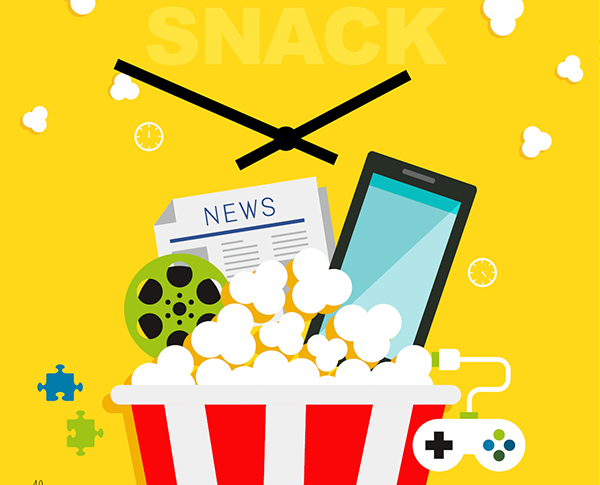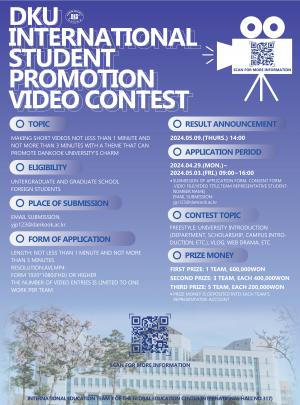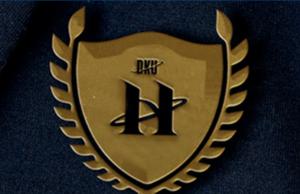 |
| ▲ We can enjoy cultures easily like snacks. |
What do you do in your free time? Do you look at web-toons or TV highlights? If you do, you are already enjoying what is quickly becoming know as ‘Snack Culture’. Snack culture is a growing trend where people enjoy their culture, the way they enjoy snacks, getting a quick fix from updates on the world around them in their spare time through the use of smart devices. Due to the popularization of smartphones, more and more people are watching films, news and video clips on these devices.
Nowadays on buses, subways and even walking on the streets, it is hard to find someone not looking at their smartphone. They are using the devices for many things, including watching short videos and news clips or reading e-books. This trend is known as ‘Snack Culture’, and the web-toons, web-dramas, e-books, card news, and short videos are our snack contents. SNS, Youtube, and mobile applications such as Pikicask, Vingle, and Kakao channel are the most common distributors of this type of snack content.
As a result of this trend, a few changes have emerged in the online industry. First, news production and magazines have changed. News outlets and magazine companies now have SNS accounts, and they provide information highlights known as ‘card news’. Each site produces several cards, so that we learn core information by reading these media snippets.
The formation of cartoons and dramas have also changed. Web-toons are said to be the origin of Snack Culture. Through the internet and on our phones, we can watch 10 minute shorts, unlike reading real comic books. In the case of TV dramas, the time spent viewing a show has changed. TV dramas usually runs about 1 hour. However, the running time of web dramas is anywhere from 5 minutes to 30 minutes. ‘Pongdang pongdang love’ and ‘72seconds drama’ are popular examples of we based dramas. So many companies use this trend to advertise their products. They target teens and twenties, and companies are able to naturally expose their products with humor, with no real burden.
The benefit of Snack Culture is that we can enjoy whatever we are watching, in a brief time, from a few seconds to a maximum of 30 minutes. Another benefit is the access we have to is diverse content. All areas of culture, whether it be humor, news, makeup, health, entertainment and so on, are readily available at our fingertips. Short performances, like 10 minute-concerts, can be watched in our spare time. In other words, the popularization of cellphones has forever altered our media production and consumption habits.
The Dankook Herald (DKH) surveyed people to learn more about their consumption habits of snack content. The DKH learned that most view news on their smartphones. More than 50% of respondents use their smartphones to watch the news. 30% searched the news through the Internet and the remaining 20% of watch television news. Almost 90% of TV viewers and some of the people who use the Internet or their smartphone to watch the news agreed that TV is the most reliable source of mass media, but many still watch the news on their smartphones because it is the easiest and the most accessible method. They cited the benefit being that they can learn general information without having to read entire articles. In other words, the advantage of reading card news through SNS on your smartphone is accessibility and convenience.
To better understand the popularity of Snack Culture, the DKH interviewed Myeong Ha-young (21). First, the DKH asked about the kinds of Snack Culture she enjoys. “I didn’t know that the media I enjoyed during my free time was considered snack content. I usually watch web-toons, web dramas, and view lots of videos on Facebook.” She added, “I can watch these things easily and enjoy them through my cellphones when I rest. They don’t take a long time to enjoy and I can get to know the issues of the nation and the world without taking up too much of my attention.” DKH asked if she thought there were any demerits to this trend. “Well for example, my acquaintance said he heard a lot about the ‘IS’ on the news. However, he didn’t know the origin of IS and what they do until he talked about it with his study group. So, we really only scratch the surface of news and information and this is a problem,” she said.
With a handheld cellphone, we can laugh, learn, and search all kinds of information. Accordingly, snack contents are provided for us every day and evolve constantly. It is good to enjoy cultural contents like we do when eating snacks. However, in order to get the full picture, we can’t lose sight of traditional media methods such as newspapers, TV and books.
허윤아, 윤지효 dankookherald@gmail.com

![[Campus Magnifier] Let's Surf the Library!](/news/photo/202404/12496_1765_4143.jpg) [Campus Magnifier] Let's Surf the Library!
[Campus Magnifier] Let's Surf the Library!
![[Campus Magnifier] Let's Surf the Library!](/news/thumbnail/202404/12496_1765_4143_v150.jpg)





